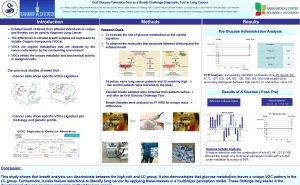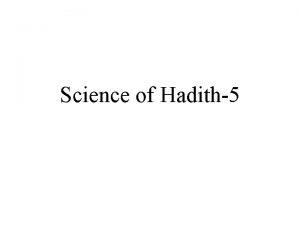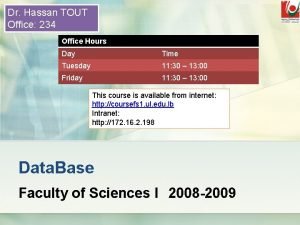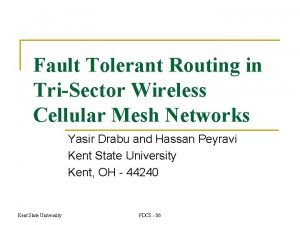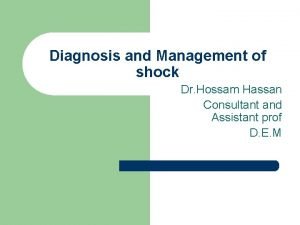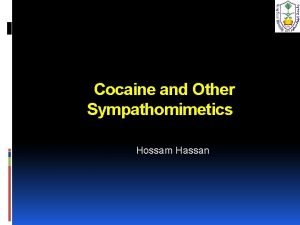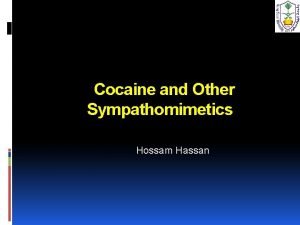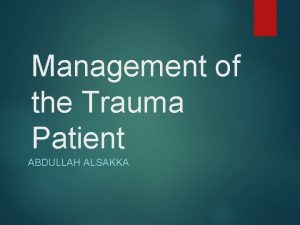Management of the Trauma Patient HOSSAM HASSAN Trauma




















- Slides: 20

Management of the Trauma Patient HOSSAM HASSAN

Trauma in the United States • 2. 7 million hospital admissions per year • Leading cause of death for ages 1 -44 years • 100, 000 deaths per year from traumatic injuries – Half die before they reach medical care • Hemorrhage is second-leading cause of death in trauma

Primary Survey • Advanced Trauma Life Support • Assess and address life threatening injuries in order • “ABCDE of trauma” – Airway – Breathing – Circulation – Neurologic “deficit” – Exposure of patient

Airway – Identify airway obstruction – Maintain cervical spine immobilization – May require definitive airway • • Orotracheal intubation Blind nasotracheal intubation Cricothyroidotomy Tracheotomy

Breathing – Identify life threatening deficits in breathing mechanism • • • Simple pneumothorax Tension pneumothorax Massive hemothorax Open pneumothorax (“sucking chest wound”) Flail chest


Circulation • Or, identification of shock Definition of shock – inadequate organ perfusion • Causes of shock – Hemorrhage/hypovolemia – Obstructive – Cardiogenic – Distributive

Class III Class IV Blood Loss m. L Up to 750 -1500 -2000 >2000 Blood Loss % Up to 15% 15 -30% 30 -40% >40% Pulse rate <100 >120 >140 Systolic blood pressure Normal Decreased Pulse pressure Normal Decreased Respiratory rate 14 -20 20 -30 30 -40 >35 Urine output >30 20 -30 5 -15 Negligible Mental status Slightly anxious Mildly anxious Anxious, confused Confused, lethargic Fluid (3: 1 rule) Crystalloid and blood

Circulation • Treatment of shock • Direct pressure on external bleeding • Initial 2 liter bolus of crystalloid fluid – Responders – Non-responders – Transient responders • Definitive management for ongoing hemorrhage

Neurologic “deficit” • Rapid assessment of neurologic status to identify life-threatening injury – Pupil size and response – Mental status (Glascow coma scale) – Motor and sensory exam

Glascow Coma Scale • 3 – 15 point scale to assess mental status only • Best observed response • GCS ≤ 8 is a “coma” and requires intubation for airway protesction

Eye opening » » None = 1 To painful stimuli only = 2 To voice only = 3 Spontaneously open = 4 Verbal response » » » None = 1 Incomprehensible sounds = 2 Incomprehensible words = 3 Confused = 4 Oriented = 5 Motor response » » » None = 1 Decerebrate (extension) posturing = 2 Decorticate (flexion) posturing = 3 Withdraws to pain = 4 Localizes pain = 5 Follows commands = 6

Exposure Head to toe examination of the patient for injury • Pitfalls – Maintenance of spine precautions – Prevention of heat loss – Under cervical collar – Back and flanks

Adjuncts to the Primary Survey • Exams during or after primary survey to aid in identifying life-threatening injuries – Chest x-ray – Pelvis x-ray – Focused abdominal sonogram for trauma (FAST) – Diagnostic peritoneal lavage (DPL)


Secondary Survey and Definitive Treatment • The secondary survey is a complete head to toe evaluation of the patient • Adjuncts to the secondary survey include CT’s, plain radiographs, blood tests • Treatment plans, especially for multiple injuries, based on clinical status and specific injuries

Resuscitation • Restoring organ perfusion • How much is enough? What are the endpoints of resuscitation? – Heart rate, blood pressure, urine output • May lead to “compensated shock” – Organ-specific indicators of perfusion • ie gastric tonometry – Global indicators of perfusion • Lactic acid, base deficit • Cardiac output, oxygen delivery, oxygen consumption • Mixed venous O 2 saturation (Sv. O 2)

Lactic acid and base deficit • Initial BD and serum LA are reliable indicators of the need for ongoing resuscitation


Questions?
 Hossam allam
Hossam allam Hossam haick
Hossam haick Patient 2 patient
Patient 2 patient Uh2 ent
Uh2 ent Khaled hosseini hassan
Khaled hosseini hassan Hassan hadith
Hassan hadith Amanda hassan
Amanda hassan Hassan chafi
Hassan chafi Mahmood ul hassan islamic aid
Mahmood ul hassan islamic aid Marwan hassan mustafa
Marwan hassan mustafa Hassan javaid
Hassan javaid Comparati baladele pasa hassan
Comparati baladele pasa hassan Olu the wave
Olu the wave Hassan amjahad
Hassan amjahad Hassan akbari
Hassan akbari Hassan tout
Hassan tout Sulamerica saude
Sulamerica saude Bnx eye drops
Bnx eye drops Hassan takabi
Hassan takabi Hassan peyravi
Hassan peyravi Dr mona hassan
Dr mona hassan

